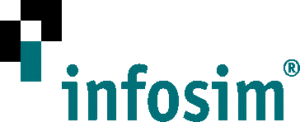Fürth, 26.06.2025
An interdisciplinary team of researchers and companies in Germany has demonstrated the integration of quantum key distribution (QKD) with Li-Fi technology for the first time. The demonstration was carried out as part of the BMBF-funded project “QuINSiDa” and showcased at the PMRExpo exhibition in Köln, Germany.

Figure 1: (Left) Two QKD nodes, connected by Li-Fi to transmit the classical QKD channel and optical fiber for the quantum QKD channel. (Middle) Closeup of the Li-Fi link connecting the two QKD nodes. (Right) Monitoring and control dashboard.
While QKD produces ultra-secure keys used for encrypting data, it relies on an optical line of sight connection to work – the very principle underlying Li‑Fi – making them a natural match. This fusion unlocks innovative applications that combine ultra‑high data security with the speed and efficiency of LED‑based Li‑Fi. Key applications include local quantum networks (Q‑LANs) for campuses, as well as fixed‑to‑mobile connections for airports, planes, shipyards, ships, and critical infrastructure.
Technological details
Developed by consortium partners, the key technologies include:
- Li-Fi (Light Fidelity): is a wireless communication technology that utilizes light to transmit data, providing high-speed data transfer, enhanced security, and minimized interference. It is specifically designed for environments where radio frequency communication is restricted or where secure data exchange is essential. The Fraunhofer IPMS Institute in Dresden is designing these systems and provided both sender and receiver within the project.
- QKD and KMS: KEEQuant GmbH in Fürth is developing a continuous‑variable quantum key distribution (CV‑QKD) system. Built on standard coherent communication fiber optics, it leverages Heisenberg’s uncertainty principle for quantum security, operates at room temperature, and fits in a standard 19″ rack. An accompanying Key Management System supplies encryption keys to applications. The project focuses on seamless system integration and protocols tailored for campus networks.
- Networking Monitoring: Monitoring systems combined with meaningful dashboards are crucial for many reasons. In addition to visualizing a general overview, it is also helpful to get deep insights into the status of individual devices or the overall health of the network. QKD applications and devices are not yet widely available, especially in a fibreless version. As part of the QuINSiDa project, we have been working on the interfaces to the QKD and KMS systems as well as to the Li-Fi and PAT systems. For the QKD connection, we have built on the ETSI QKD standards. The PMR-Expo dashboard provided by Infosim® shows a logical representation of the demo with status indicators of each device. In addition, the relevant metrics, such as key rate and error rate, were visualized as time series.
Integrating these technologies enabled a two‑node demonstration in which the classical communication channel between CV‑QKD devices—typically connected by cable—was replaced by a wireless Li‑Fi link.
BESCom GmbH, investigating these use cases, predicts that mobile high‑security data communication will play a crucial role in the future of both mobile and optical networks.
The optical fiber linking the quantum components of the two QKD systems will later be replaced by a telescope developed by Fraunhofer IPMS, enabling a fully wireless system. Moreover, project partners plan to integrate an encrypted link (Telco Tech GmbH) and an entanglement‑based QKD system (Fraunhofer IOF, Jena), laying a robust foundation for future experiments and products targeting high‑security campus networks and fixed‑to‑mobile scenarios. Stay tuned for further updates as the project advances.
Funding acknowledgement
This project was funded by the Federal Ministry of Education and Research (BMBF) under project number 16KISQ082K.
Partner details
Fraunhofer IPMS is a leading international research and development service provider for electronic and photonic microsystems in the application fields of Smart Industrial Solutions, Bio and Health, Mobility as well as Green and Sustainable Microelectronics. Research focuses on customer-specific miniaturized sensors and actuators, MEMS systems, microdisplays and integrated circuits as well as wireless and wired data communication. The institute develops systems and components on 200 and 300 mm wafers in their state-of-the-art clean rooms. Services range from consulting and design to process development and pilot series production. Contact: Stephan Kube: stephan.kube@ipms.fraunhofer.de
Infosim® is a leading provider of automated Service Fulfillment and Service Assurance solutions for Telcos, ISPs, Managed Service Providers, and Corporations. Since 2003, Infosim® has been developing and improving upon StableNet®, one of the leading automated network and services management platform with a 4-in-1 solution that combines Discovery & Inventory, Configuration, Fault, and Performance Management.” Contact: Dr. Stefan Kremling: kremling@infosim.net
Founded in 2020, KEEQuant GmbH is a startup company specializing in quantum-safe communication. With the mission of securing today’s communication and network infrastructure, KEEQuant develops and supplies Quantum Key Distribution (QKD) and Key Management Systems (KMS), featuring a hybrid integration of Post-Quantum Cryptography (PQC) to enable future-proof solutions. By employing proven secure methods, KEEQuant ensures that security-critical data streams remain protected against future attacks by quantum computers. As a company fully based and financed within the EU27, KEEQuant is committed to delivering trustworthy solutions even for the most demanding and critical applications. Contact: press@keequant.com
 |
 |
 |
 |
 |
 |
